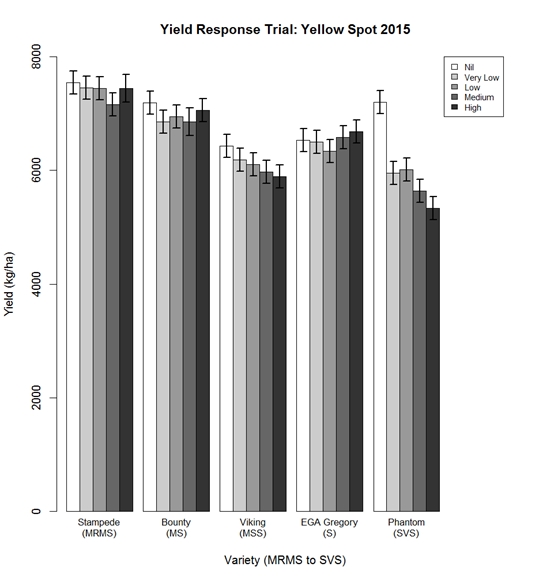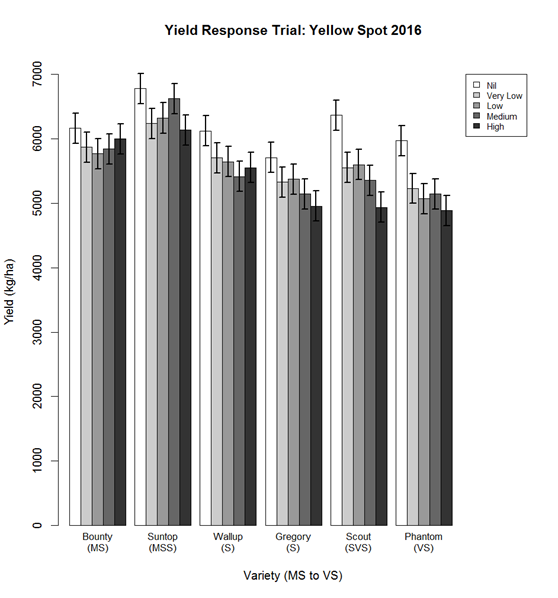Yellow leaf spot trials and the economics of spraying
Author: Lislé Snyman, Greg Platz, Clayton Forknall Dept of Agriculture and Fisheries Queensland | Date: 09 Mar 2017
Take home message
- Crop rotation and reducing surface stubble decrease inoculum levels
- Do not sow susceptible wheat varieties into wheat stubble
- Economic response to fungicide application is a factor of varietal susceptibility, severity of the epidemic, product choice and timing of application.
- Increasing moisture periods increase the incidence and severity of yellow spot
Introduction
Yellow spot is a stubble-borne fungal disease caused by the pathogen Pyrenophora tritici-repentis. It causes yield loss and reduced grain quality. Yield loss depends on varietal resistance and severity of the disease.
Symptoms include tan-coloured oval lesions becoming darker in the centre with a yellow margin, often observed in young seedling leaves from where the disease moves up the plant under suitable conditions. As lesions merge and coalesce, they produce large areas of necrotic tissue, causing leaf death and reducing photosynthetic area.
The fungus survives as small, black fruiting bodies on stubble. From there, fungal spores are released after rain events and spread onto nearby seedlings, resulting in primary infection. Secondary spread occurs when asexual spores are produced on leaves and dispersed by wind, infecting new leaves and neighbouring crops.
At least six hours of leaf wetness with temperatures of 15-28oC are required for the successful infection of leaves from stubble. Secondary infection (leaf to leaf) is favoured by leaf wetness, high humidity and optimum temperatures between 15oC and 25oC.
Successful management requires an integrated disease management approach including crop rotation (i.e. avoid wheat on wheat), timely application of fungicides to protect the money leaves (flag and flag-1), removal of stubble and using resistant varieties. Crops deficient in nitrogen and/or potassium have been shown to be more vulnerable to infection. Stubble of susceptible varieties harbours more inoculum, hence avoid sowing a susceptible variety into stubble from a previously infected susceptible crop at all cost.
Yield loss associated with yellow spot
The impact of yellow spot on grain yield of a susceptible variety under conditions favourable for disease development was demonstrated in the variety Banks, where yield losses reached 60%. Most of that could be attributed to a reduction in grain size (Rees & Platz, 1989).
In an attempt to quantify yield losses caused by yellow spot in current varieties, a trial was conducted in 2013 with four varieties ranging from moderately resistant (MR) to susceptible (S) to yellow spot. Varieties included were Leichhardt (MR), Kennedy (MSS), Kidman (S) and EGA Gregory (S).
Treatments applied included a full fungicide treatment, early spray (GS31), late spray (GS39), early+late spray and a nil fungicide treatment. The full fungicide treated plots were sprayed on three occasions, approximately 2-3 weeks apart, with the first spray 14 days before the early application.
Results indicated significantly higher yield loss in the varieties EGA Gregory and Kidman, rated susceptible to yellow spot. In both these, the full spray application yielded significantly higher than all the other treatments. The full spray was significantly higher than the late spray and the nil spray only for Leichhardt (MR). In the variety Kennedy (MSS), the full spray was significantly higher than the nil spray, the late spray and the 2 sprays (early+late).
Another trial conducted in 2015 included five varieties, ranging from MRMS to SVS and a range of disease levels i.e. nil disease (full sprayed treatment), very low disease, low disease, medium disease and high disease levels. The yield response of the different varieties at different disease levels are displayed in Fig. 1.

Figure 1. Yield response of wheat varieties to different levels of yellow spot in 2015
No significant differences were observed between any of the treatments in the varieties Stampede (MRMS), Bounty (MS) and EGA Gregory (S), with very little yield loss observed across treatments. The nil disease treatment yielded significantly higher than the high disease treatment in Viking (MSS), with no significant differences between the diseased treatments. The biggest yield loss was observed in Phantom (SVS), with a 25.9% yield increase in the nil disease over the high disease treatment. The high disease treatments only delivered a moderate epidemic.
Similar results were observed in the variety Bounty (MS) in 2016 under heavier epidemics with no significant difference in yield between any of the treatments and very little yield loss. Variable results were obtained in the varieties Suntop (MSS), Wallup (S) and EGA Gregory (S) where the nil disease treatments yielded significantly better than some of the diseased treatments, but not all of them (Fig. 2). The high disease treatment of EGA Gregory suffered a yield loss of 13.2% when compared to the nil disease, higher than yield loss measured in the varieties Suntop (9.5%) and Wallup (9.3%). A significant yield advantage of 22.5% was evident in Scout (SVS) and 18.2% in Phantom (VS) when comparing the nil disease and high disease treatments.

Figure 2. Yield response of wheat varieties to different levels of yellow spot in 2016
Implications
Results obtained varied between varieties and seasons. Over the three years, varieties with higher levels of resistance to yellow spot were less impacted by the disease, whereas bigger yield loss occurred in varieties rated as S or worse. Variable results were obtained across years in EGA Gregory and could possibly be attributed to differences in disease pressure, environment and the maturity of the variety. It was noted by Rees & Platz (1989) that disease levels on later maturing varieties were generally lower than on earlier varieties at any given time.
Yield losses of approximately 20% were observed under moderate disease pressure in varieties rated S to VS with Phantom ranging between 18.2% in 2016 and 25.9% in 2015 whereas yield loss in Kidman was 23.1% in 2014 and 22.5% in Scout in 2016.
In looking at the economics of fungicide application (Table 1) for the control of yellow spot, it is evident that fungicide application is more profitable in more susceptible varieties. It is however important to note that the differences quoted here were a result of three sprays used in the full spray/nil disease treatment and the same level of control may not be possible with a single fungicide application. The timing of a single fungicide application will be crucial in minimizing yield loss. These results support earlier findings that a single fungicide application can be very economical on susceptible varieties in high yielding, high disease pressure years (Colson, 2004).
Table 1. Economics of fungicide application in 2016 yield response trial
|
Variety |
Treatment |
Fungicide cost (3 sprays) ($/ha)* |
Yield (t/ha) |
Yield increase (%) |
Income ($/ha)** |
Extra net ($/ha) |
|
Bounty (MS) |
High disease |
0 |
6.00 |
0 |
1500 |
0 |
|
Nil disease |
60 |
6.16 |
2.60 |
1540 |
-20 |
|
|
Suntop (MSS) |
High disease |
0 |
6.14 |
0 |
1535 |
0 |
|
Nil disease |
60 |
6.78 |
9.44 |
1695 |
100 |
|
|
Wallup (S) |
High disease |
0 |
5.55 |
0 |
1387.5 |
0 |
|
Nil disease |
60 |
6.12 |
9.31 |
1530 |
82.5 |
|
|
EGA Gregory (S) |
High disease |
0 |
4.96 |
0 |
1240 |
0 |
|
Nil disease |
60 |
5.71 |
13.13 |
1427.5 |
127.5 |
|
|
Scout (SVS) |
High disease |
0 |
4.93 |
0 |
1232.5 |
0 |
|
Nil disease |
60 |
6.36 |
22.48 |
1590 |
297.5 |
|
|
Phantom (VS) |
High disease |
0 |
4.89 |
0 |
1222.5 |
0 |
|
Nil disease |
60 |
5.97 |
18.09 |
1492.5 |
210 |
*$20/ha/application
**$250/t APH1/APH2 Goondiwindi
Conclusion
These results confirm previous reports that yield and quality losses as a result of yellow spot infection, are greater in more susceptible varieties than in varieties with some level of resistance to the pathogen (Colson et al., 2003; Rees & Platz, 1989). Consequently, it is important to consider the economic benefit in applying fungicide to a variety with good levels of resistance, unless disease pressure is very high and the environment conducive to further disease development.
Management of yellow spot is best achieved with an integrated approach of varietal resistance, stubble management, crop rotation and timely fungicide application if required. Disease control will be easier in varieties with some level of resistance even though responses to fungicide application may not be as impressive as in a VS variety. Always be aware that fungicides are more effective if applied prior to infection events.
A much greater proportion of our wheat cropping area is sown to varieties with useful levels of resistance to yellow spot than a decade ago; therefore it is worthwhile to consider the economics of fungicide application in relation to varietal resistance and epidemic potential before spraying. The preliminary data shown above suggests that application of fungicides to varieties that are rated less than MSS may not always be profitable. Yield loss response curves for the wheat/yellow spot system are being developed under a national GRDC project and will aid in making these critical management decisions.
References
Colson ES, 2004. Foliar diseases in wheat: yellow spot – epidemiology, commercial impact and strategies for management. GRDC updates Goondiwindi.
Colson ES, Platz GJ & Usher TR, 2003. Fungicidal control of Pyrenophora tritici-repentis in wheat. Australasian Plant Pathology 32, 241-246.
Rees RG & Platz GJ, 1989. Effectiveness of incomplete resistance to Pyrenophora tritici-repentis in wheat. Australian Journal of Agricultural Research 40, 43-48.
Acknowledgements
The research undertaken as part of this project is made possible by the significant contributions of growers through both trial cooperation and the support of the GRDC, the author would like to thank them for their continued support.
The author would like to thank the technical - and farm staff at Hermitage Research Facility for their assistance.
Contact details
Lislé Snyman
DAF QLD
Hermitage Research Facility, 604 Yangan Rd, Warwick, Qld
Ph: 07 4660 3661
Email: lisle.snyman@daf.qld.gov.au
Greg Platz
DAF QLD
Hermitage Research Facility, 604 Yangan Rd, Warwick, Qld
Ph: 07 4660 3633
Email: greg.platz@daf.qld.gov.au
Clayton Forknall
DAF QLD
13 Holberton St, Toowoomba, Qld
Ph: 07 4529 1218
Email: clayton.forknall@daf.qld.gov.au
Varieties displaying this symbol beside them are protected under the Plant Breeders Rights Act 1994
GRDC Project Code: DAW00245,
Was this page helpful?
YOUR FEEDBACK
